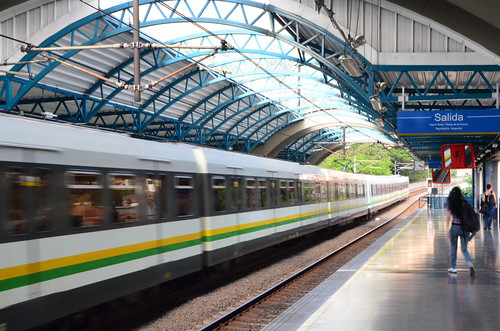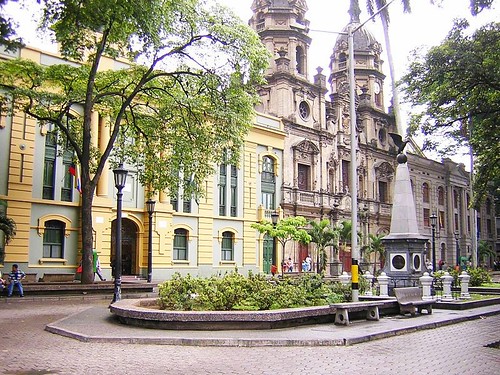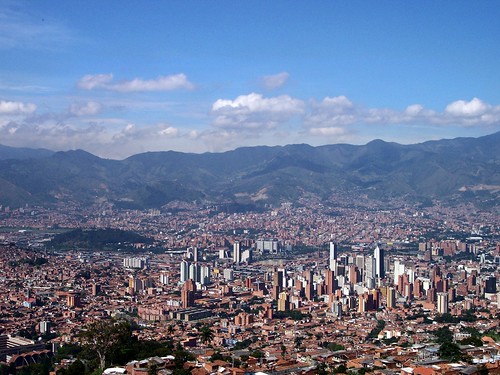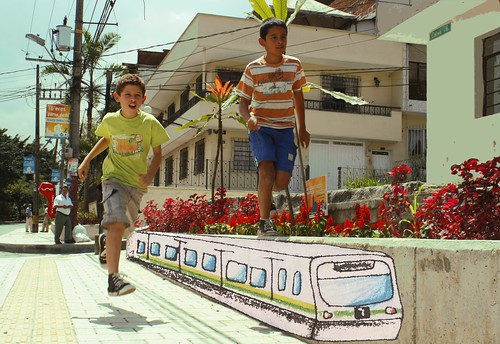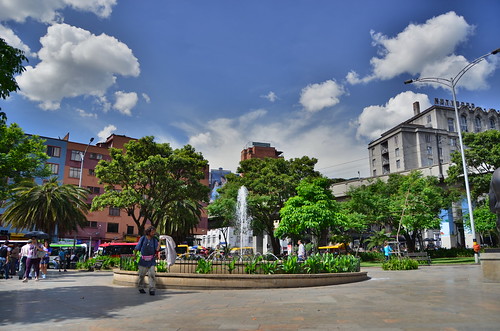Can innovative transportation help "the most dangerous city in the world" shake its reputation?

Posted October 23, 2013 at 1:24PM
The physical beauty and many cultural and commercial institutions of Medellin, the second-largest city in Colombia, mask its well-earned reputation for violence. The city’s troubles were and, to a somewhat lesser degree, remain real, but there are encouraging signs that the city is turning around. The reasons are many and complex, but impressive investment by the city in its infrastructure – including its transportation systems – is part of the story. Once dubbed the most dangerous city in the world, earlier this year Medellin was named the international “innovative city of the year” for its remarkable progress.
Indeed, as recently as 20 years ago Medellin was known for extreme violence, fueled by drug wars between the notorious Medellin Cartel, its rivals, and the state. While killings and other crime subsided somewhat after the death of Cartel kingpin Pablo Escobar in the 1990s, many districts are still “ruled” by armed criminal gangs not unlike the outlaw militias that control many of the favelas of Rio de Janeiro.
Even recently, crime has been on the upswing. In 2009, according to the city’s Wikipedia entry, there were about 110 violent deaths per 100,000 people in Medellin, “2.5 times the average homicide rate in Colombia and 20 times the average homicide rate in the United States for that same year.”
Still, there are signs that things are improving. The Urban Land Institute has reported that the homicide rate has plunged nearly 80 percent from 1991 to 2010, and that the city has made enormous public investments to improve residents’ quality of life:
“The city built public libraries, parks, and schools in poor hillside neighborhoods and constructed a series of transportation links from there to its commercial and industrial centers. The links include a metro cable car system and escalators up steep hills, reducing commute times, spurring private investment, and promoting social equity as well as environmental sustainability. In 2012, the Institute for Transportation and Development Policy recognized Medellín’s efforts with the Sustainable Transportation Award . . .
“Transportation projects are financed through public-private partnerships; engineering firms have designed public buildings for free; and in 2006, nine of the city’s largest firms funded a science museum. In addition, Medellín is one of the largest cities to successfully implement participatory budgeting, which allows citizens to define priorities and allocate a portion of the municipal budget. Community organizations, health centers, and youth groups have formed, empowering citizens to declare ownership of their neighborhoods.”
Medellin also has the only modern rail transit system in Colombia. The Medellin Metro has a one-ticket transfer interface with the city’s cable cars and bus system.
It would seem quite a stretch to argue that transportation and public works improvement have been the major reason for slowly improving social conditions and safety in the city. An excellent essay written by Ed Vulliamy and published this summer in The Guardian documents in some detail both the progress and the continuing challenges. But Vulliamy’s article acknowledges that the infrastructure improvements are significant:
“The cable car floats over the mountainside above rickety rooftops, labyrinthine streets, palms and pylons of a barrio built by, and named after, the most renowned criminal of all time – Pablo Escobar. Below it lies what was until recently the fortress of the cocaine king, on the northeast edges of Medellín in Colombia . . .
“The cable car is an articulation of the change since the street and warrens were Escobar's fiefdom. As is the building that towers above the barrio's skyline, a granite cliff of award-winning modernist design, the parque biblioteca, or library park, where some of the poorest people in the world come to study, use a computer or just seek respite.
“These are symbols of defiance and resurgence in Medellín, two decades ago the most dangerous and murderous city on the planet. A place where several car bombs a day could explode as Escobar's cartel went to war with the state, its apparatus, elites and society at large. They are part of a bold civic and political venture: to force breathing spaces into the desperately poor and exhausted barrios on the city's frayed outskirts, in which peace and even opportunity might stand a chance of prevailing.”
The investment in transport facilities and public spaces is significant, and not limited to the Metro and cable cars. In announcing its 2012 award to the city for sustainable transportation, the Institute for Transportation & Development Policy cited the following:
- Improvement of public spaces with better pedestrian connections, environmental parks, and urban promenades, as part of the city’s Urban Integral Project.
- A public bikesharing program called "EnCicla" that has begun by integrating universities and mass transit, along with other key destinations of the city.
- The development and inauguration of "Metroplús," a bus rapid transit project that is fully integrated (physically and fare) with the metro and cable car.
- Improvement of street crossings that were unsafe and where universal accessibility was needed.
- Reduction in air pollution through vehicle emission control and improved sulfur content of fuels.
- A ridesharing program ("Comparte tu carro") that, as of time of the award, had enlisted the participation of 171 institutions.
- Use of the internet and social media to provide a venue for information to and feedback from users about mobility choices.
- An “intelligent mobility system” using technology to improve road safety and mobility for all users.
There is also a ciclovia which closes some roads on Sundays, making them available to families car-free for cycling and recreation.
In many ways, the reforms in Medellin evoke those championed in Bogotá, the Colombian capital, by that city’s charismatic former mayor, Enrique Penalosa. An advocate of BRT, bicycling, and parks, Penalosa became known for the notion of “constructing a city around the concept of happiness.” At the time of Penalosa’s reforms, Medellin was unfortunately far too caught up in its period of extreme violence to entertain the kinds of amenities the city is now providing.
In an article posted on the Sustainable Cities Collective in 2011, the American Planning Association cites Medellin’s own progressive former mayor, Sergio Fajardo, for leading many of the reforms that are now contributing to the city’s turnaround, including the targeting of poor neighborhoods for special attention and public engagement:
“Sergio Fajardo was elected mayor in 2004, with the belief that policies aimed at repairing the city’s damaged social fabric could alleviate the intertwined problems of inequality and violence. A primary element of his plan was the construction of beautiful public architecture in the city’s poorest neighborhoods, such as the Parque Biblioteca España [library park] in the Santio Domingo Savio barrio. Fajardo stated, ‘Architecture sends an important political message…When you go to the poorest neighborhood and build the city’s most beautiful building, that gives a sense of dignity.’
“With their ‘social urbanism’ philosophy, Fajardo and his contemporaries literally built bridges (and trams) that connected poor neighborhoods to areas of economic vitality, created digital maps that allowed the government to better understand how gangs operated, and devised architectural features to disrupt violence. Fajardo also engaged citizens through participatory budgeting, an innovative process highlighted in a recent NPR story. Through participatory budgeting, ‘citizens define priorities, and public money is allocated accordingly’ for 5 percent of the municipal budget.”
The innovations have been continued by the city’s current mayor, Anibal Gaviria.
Whatever the cause, some of Medellin’s environmental performance is impressive. The APA article cites the Latin American Green City Index published by Siemens in 2010:
“Residents boast the lowest amount of waste per capita of the seventeen cities in the Index, and Medellín has the ‘longest mass transport network, the best rate of wastewater treatment, and the highest percentage of people with access to sanitation’ compared to other cities in its income bracket. The Index also emphasized ‘green initiatives’ such as improvements to water infrastructure, aggressive congestion reduction and traffic control policies, and the Integral Urban Project that focuses development efforts in low-income areas.”
Earlier this year, Medellin was named “Innovative City of the Year” by Citi and the Wall Street Journal, with the assistance of the Urban Land Institute.
For a closer look at Medellin’s significant transportation innovations, check out this video from Streetfilms:
Related posts:
- Stabilizing & greening the favelas: Rio's formidable challenge (October 21, 2013)
- Constructing a city around the concept of happiness (March 5, 2010)
- Nice video on Curitiba's car-free main street (July 9, 2009)
Move your cursor over the images for credit information.
